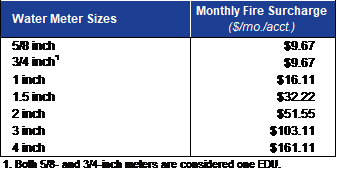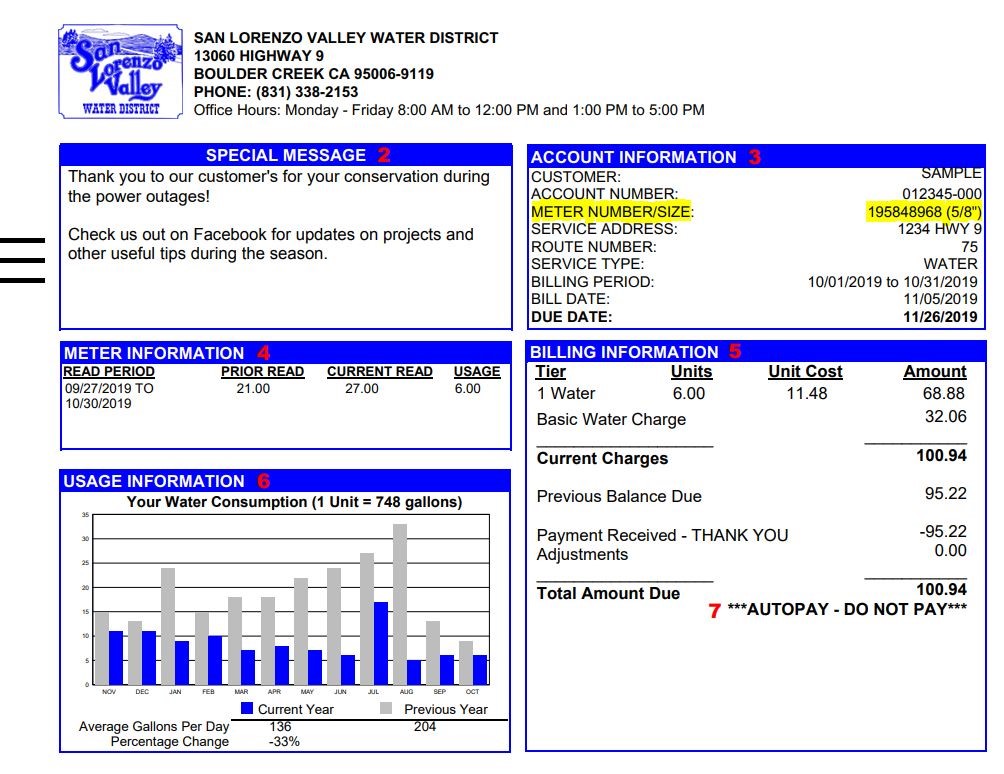Prop 218 - Frequently Asked Questions (FAQ)
RATE CHANGES FREQUENTLY ASKED QUESTIONS
Why Is the District Considering a Surcharge on Water Rates?
The District was severely impacted by the CZU Wildfire. The District’s water system sustained extensive damage including to raw water supply lines, storage tanks, water treatment systems, pumps, water quality monitoring equipment, and water transmission pipeline. Also, the District also participated in the CZU Wildfire emergency response effort and incurred various response and recovery costs. A list of CZU Wildfire projects has been submitted to the Federal Emergency Management Agency (FEMA) as part of a request for Public Assistance. The District’s total estimated cost of the projects is over $20 million.
The District will be responsible to pay all of these costs (and other CZU Wildfire costs) up front and will submit eligible project costs for FEMA reimbursement, upon completion. The District has taken on long-term debt to help cover the costs, especially up-front costs. The District anticipates receiving approximately 75% FEMA reimbursement of eligible costs. Insurance proceeds will be deducted from FEMA reimbursement amounts. The total net cost of the projects to the District after FEMA reimbursement is estimated to be approximately $5 million, although the final amount could be more or less than the estimated $5 million. This $5 million is an unplanned cost. Without the Surcharge, CZU Wildfire expenses will continue to deplete the District’s reserves and pull funds away from other critical infrastructure projects needed throughout the District, thereby creating long-term financial challenges related to providing reliable, safe, and high quality water to all the District’s customers.
Responding under the extreme emergency conditions presented by the wildfire required unprecedented demands on the District’s operating budgets. The District plans for a certain amount of contingency with every budget but the demands created by this extraordinary fire required the SLVWD to use nearly everything it held in reserves to quickly and safely restore water service to ensure SLVWD customers could return home.
How Would Revenues from the Proposed Surcharge Be Used?
The District’s Board has directed that if the proposed Surcharge is approved, all Surcharge revenues received by the District will be maintained in a restricted fund or account from which CZU Wildfire expenses will be payable. The District will track CZU Wildfire costs against the revenues generated by the Surcharge.
The District has taken on long-term debt to help cover the costs of the CZU Wildfire, especially up-front costs. Interest on this debt has not been factored into the amount of the Surcharge, even though debt-related expenses for the CZU Wildfire would be payable from the Surcharge revenues. The proposed Surcharge would end automatically once a total $5 million Surcharge revenues are collected by the District. The Surcharge could be terminated early by the District’s Board if it turns out that the District’s CZU Wildfire net costs will be less than $5 million.
What Did the District’s Loan Cover?
Recognizing that reimbursements from the Federal Emergency Management Agency (FEMA) could not be made until after work was completed, the District took out a low-interest loan to restore its reserves and provide the capital necessary to begin fire recovery work.
What Will FEMA Reimburse?
A list of CZU Wildfire projects has been submitted to the Federal Emergency Management Agency (FEMA) as part of a request for Public Assistance. The District’s total estimated cost of the projects is over $20 million. The District will be responsible to pay all of these costs (and other CZU Wildfire costs) up front and will submit eligible project costs for FEMA reimbursement, upon completion.
The District has taken on long-term debt to help cover the costs, especially up-front costs. The District anticipates receiving approximately 75% FEMA reimbursement of eligible costs. Insurance proceeds will be deducted from FEMA reimbursement amounts. The total net cost of the projects to the District after FEMA reimbursement is estimated to be approximately $5 million, although the final amount could be more or less than the estimated $5 million. This $5 million is an unplanned cost.
What About Insurance?
- Agencies receiving FEMA funding must reduce FEMA’s portion of the reimbursement by the amount of any insurance proceeds received. Therefore, insurance proceeds reduce the amount of FEMA funding available. Insurance has no impact on the agency’s obligation to pay 25% of FEMA-eligible expenses.
- Insurance carriers, such as the Districts’ risk management provider, do not offer property damage coverage for all types of infrastructure. For example, facilities such as a water storage tank or pump house may be covered by insurance, whereas pipelines often cannot be insured.
- For that reason, wildfire damage to some of the District’s most expensive infrastructure – the 5 mile pipeline, for example – was not covered by insurance. Therefore insurance alone cannot replace the damaged infrastructure.
Can the District Recover Without the Surcharge?
Without the Surcharge, CZU Wildfire expenses will continue to deplete the District’s reserves and pull funds away from other critical infrastructure projects needed throughout the District, thereby creating long-term financial challenges related to providing reliable, safe, and high quality water to all the District’s customers.
How Would Revenues from the Proposed Surcharge Be Used?
The District’s Board has directed that if the proposed Surcharge is approved, all Surcharge revenues received by the District will be maintained in a restricted fund or account from which CZU Wildfire expenses will be payable. The District will track CZU Wildfire costs against the revenues generated by the Surcharge.
When Would the Proposed Surcharge End?
The proposed Surcharge would end automatically once a total $5 million Surcharge revenues are collected by the District. The Surcharge could be terminated early by the District’s Board if it turns out that the District’s CZU Wildfire net costs will be less than $5 million.
How Much Is the Proposed Surcharge?
The District is proposing a fixed monthly surcharge rate based on billing meter size, in the amounts shown in the table below.If adopted, the Surcharge would be added to each customer’s monthly water bill starting with bills processed on or after August 20, 2021.

You can determine your meter size by reviewing your water bill. If you receive paper bills, your meter size is listed within “account information”, under meter number/size. See example bill below for further detail. If you receive electronic billing, you can determine your meter size by your basic monthly charge. For example, if your basic monthly cost is $33.66 then your meter size is 5/8 inch. See table 2 below for further detail.
Billing Meter Size | Basic Monthly Charge | Monthly Fire Surcharge |
5/8 inch | $ 33.66 | $ 9.67 |
3/4 inch | $ 33.66 | $ 9.67 |
1 inch | $ 50.45 | $ 16.11 |
1.5 inch | $ 92.43 | $ 32.22 |
2 inch | $ 142.80 | $ 51.55 |
3 inch | $ 277.12 | $ 103.11 |
4 inch | $ 428.23 | $ 161.11 |
Table 2: Billing meter size vs. basic monthly charge




